Flaxseed Gum Solution Functional Properties
Abstract
1. Introduction
2. Materials and Methods
2.1. Materials and Chemicals
2.2. FG Sample Preparation
2.2.1. Hot Water Extraction
2.2.2. Sample Separation
2.3. Physicochemical Properties
2.3.1. FG Yield
2.3.2. The pH Measurement
2.3.3. Color Measurement
2.3.4. Optical Density Measurement
2.3.5. Viscosity Measurement
2.3.6. Foamability Analysis
2.3.7. Emulsification Property Analysis
2.4. Statistical Analysis
3. Results and Discussion
3.1. FG Yield and pH
3.2. Color Analysis
3.3. Light Scattering and Absorption
3.4. Viscosity Analysis
3.4.1. Viscosity During Storage
3.4.2. Effect of Salt (NaCl) on Viscosity
3.4.3. Freeze-Thaw Effects on FG Viscosity
3.5. Foamability Analysis
3.6. Emulsification Capacity and Emulsion Stability
4. Conclusions
Author Contributions
Funding
Acknowledgments
Conflicts of Interest
References
- Oomah, B.D.; Mazza, G. Flaxseed proteins—A review. Food Chem. 1993, 48, 109–114. [Google Scholar] [CrossRef]
- Shim, Y.Y.; Gui, B.; Wang, Y.; Reaney, M.J.T. Flaxseed (Linum usitatissimum L.) oil processing and selected products. Trends Food Sci. Technol. 2015, 43, 162–177. [Google Scholar] [CrossRef]
- The Food and Agriculture Organization of the United Nations. FAOSTAT Database: Agricultural Crops. Available online: http://www.fao.org/faostat/en/#data/QC/visualize (accessed on 14 May 2020).
- Huang, H.; Zhang, S. Flaxseed nutrient composition and application in food industry. Food Res. Dev. 2006, 27, 147–149. [Google Scholar]
- Kalac, J. Linseed (Linum usitatissimum). J. Biol. Prod. 1975, 20, 58. [Google Scholar]
- Cho, J.Y.; Sung, N.Y.; Jung, D.; Ratan, Z.A.; Shim, Y.Y.; Reaney, M.J.T. Composition for treating inflammatory disease comprising cyclic peptide mixture. Korean Patent 10-101763475B1, 1 August 2017. [Google Scholar]
- Morris, D.H. Flax: A Health and Nutrition Primer, 3rd ed.; Flax Council of Canada: Winnipeg, MB, Canada, 2003; p. 11. [Google Scholar]
- Shim, Y.Y.; Gui, B.; Arnison, P.G.; Wang, Y.; Reaney, M.J.T. Flaxseed (Linum usitatissimum L.) bioactive compounds and peptide nomenclature: A review. Trends Food Sci. Technol. 2014, 38, 5–20. [Google Scholar] [CrossRef]
- Liu, J.; Shim, Y.Y.; Tse, T.J.; Wang, Y.; Reaney, M.J.T. Flaxseed gum a versatile natural hydrocolloid for food and non-food applications. Trends Food Sci. Technol. 2018, 75, 146–157. [Google Scholar] [CrossRef]
- Fedeniuk, R.W.; Biliaderis, C.G. Composition and physicochemical properties of linseed (Linum usitatissimum L.) mucilage. J. Agric. Food Chem. 1994, 42, 240–247. [Google Scholar] [CrossRef]
- Liu, J.; Shim, Y.Y.; Shen, J.; Wang, Y.; Ghosh, S.; Reaney, M.J.T. Variation of composition and functional properties of gum from six Canadian flaxseed (Linum usitatissimum L.) cultivars. Int. J. Food Sci. Tech. 2016, 51, 2313–2326. [Google Scholar] [CrossRef]
- Erskine, A.J.; Jones, K.N. The structure of linseed mucilage, Part I. Can. J. Chem. 1957, 35, 1174–1183. [Google Scholar] [CrossRef]
- Glicksman, M. Food applications of gums. In Food Carbohydrates; Lineback, D.R., Inglett, G.E., Eds.; AVI Publishing Co., Inc.: Westport, CT, USA, 1982; pp. 270–295. [Google Scholar]
- Chen, H.; Xu, S.; Wang, Z. Film and foam properties of flaxseed gum. Food Ferment. Ind. 2006, 32, 34–36. [Google Scholar]
- Xu, S.; Li, W. Study on characteristic of flaxseed gum. Heilongjiang Sci. Technol. Inf. 2007, 11, 32–33. [Google Scholar]
- Dickson, E. Hydrocolloids at interface and the influence on the properties of the dispersed system. Food Hydrocoll. 2003, 17, 25–39. [Google Scholar] [CrossRef]
- Sun, X.; Shi, F.; Zhao., X. Property analysis of flax gum—Flax gum viscosity and emulsifying property. China Food Addit. 2001, 4, 7–11. [Google Scholar]
- Chen, H.; Xu, S. Emulsion property of flaxseed gum. J. Food Sci. Biotechnol. 2006, 25, 21–26. [Google Scholar]
- Glicksman, M. Gum Technology in the Food Industry; Academic Press: New York, NY, USA, 1969. [Google Scholar]
- Xing, X.; Wei, A.; Wang, Y. Effect of extraction temperature on the rheological properties of flaxseed gum. J. Henan Univ. Technol. 2015, 36, 46–51. [Google Scholar]
- Cui, W.; Mazza, G.; Oomah, B.D.; Biliaderis, C.G. Optimization of an aqueous extraction process for flaxseed gum by response surface methodology. LWT Food Sci. Technol. 1994, 27, 363–369. [Google Scholar] [CrossRef]
- Liang, X.; Li, Q.; Xu, G. Study on extraction technique of flaxseed gum. Food Eng. 2011, 2, 11–13. [Google Scholar]
- Attwood and Binsted. USDA Approves tomato color meter. Food Trade Rev. 2003, 73, 546. [Google Scholar]
- Norcross Corporation. Viscosity Conversion Tablews; Norcross Corporation: Newton, MA, USA, 2015; Available online: http://www.ecsnottingham.co.uk/downloads/news/August%202010%20Viscosity%20Conversion%20Table.pdf (accessed on 14 May 2020).
- O’Lenick, A.J., Jr. Silicone quaternary compounds. Cosmet. Toilet. 1994, 109, 85–89. [Google Scholar]
- Zhang, L. Study on the Extraction and Functional Properties of Flaxseed Gum from Flaxseed Flake. Master’s Thesis, Tianjing University, Tianjing, China, 2009. [Google Scholar]
- Cui, S.W.; Ikeda, S.; Eskin, M.N.A. Seed polysaccharide gums. In Functional Food Carbohydrates; Biliaderis, C.G., Izydorczyk, M.S., Eds.; CRC Press: Boca Raton, FL, USA, 2006; pp. 127–166. [Google Scholar]
- Chen, H.; Xu, S.; Wang, Z. Gelation properties of flaxseed gum. J. Food Eng. 2006, 77, 295–303. [Google Scholar] [CrossRef]
- Mazza, G.; Biliaderis, C.G. Functional properties of flax seed mucilage. J. Food Sci. 1989, 54, 1302–1305. [Google Scholar] [CrossRef]
- Moczkowska, M.; Karp, S.; Niu, Y.; Kurek, M.A. Enzymatic, enzymatic-ultrasonic and alkaline extraction of soluble dietary fibre from flaxseed—A physicochemical approach. Food Hydrocoll. 2019, 90, 105–112. [Google Scholar] [CrossRef]
- O’Mullane, J.E.; Hayter, I.P. Linseed mucilage. Int Patent PCT WO1993016707A1, 2 September 1993. [Google Scholar]
- Huang, L. Food Thickener, 2nd ed.; Huang, L., Ed.; China Light Industry Press: Beijing, China, 2009. [Google Scholar]
- Liu, X.; Han, R.; Yun, H.; Jung, K.; Jin, D.; Lee, B.; Min, T.; Jo, C. Effect of irradiation on foaming properties of egg white proteins. Poult. Sci. 2009, 88, 2435–2441. [Google Scholar] [CrossRef] [PubMed]
- Tan, H.; Mao, Z.; Yang, H. Experimental study on spray drying of flaxseed gum. Trans. Chin. Soc. Agric. Eng. 2004, 6, 197–200. [Google Scholar]
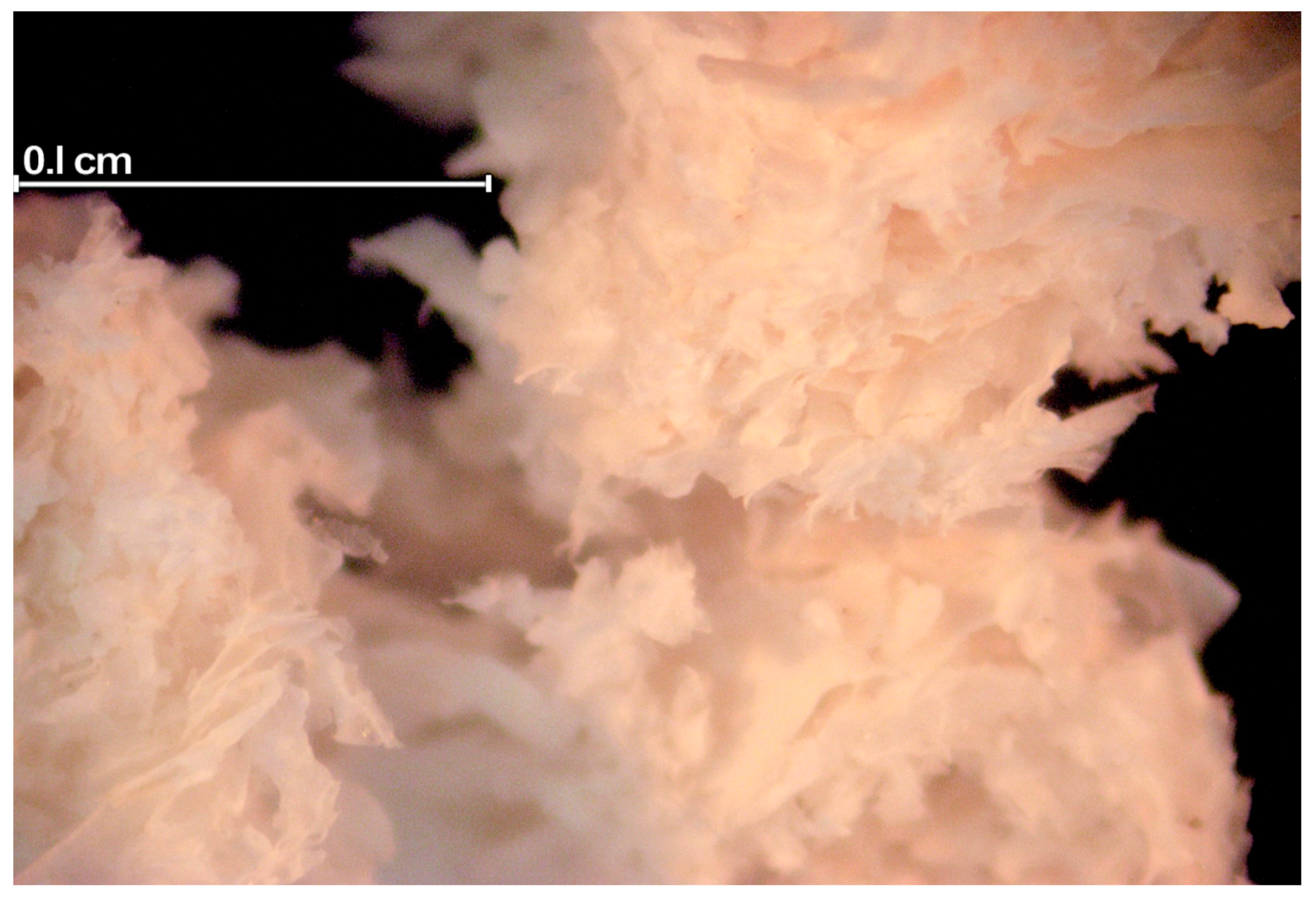
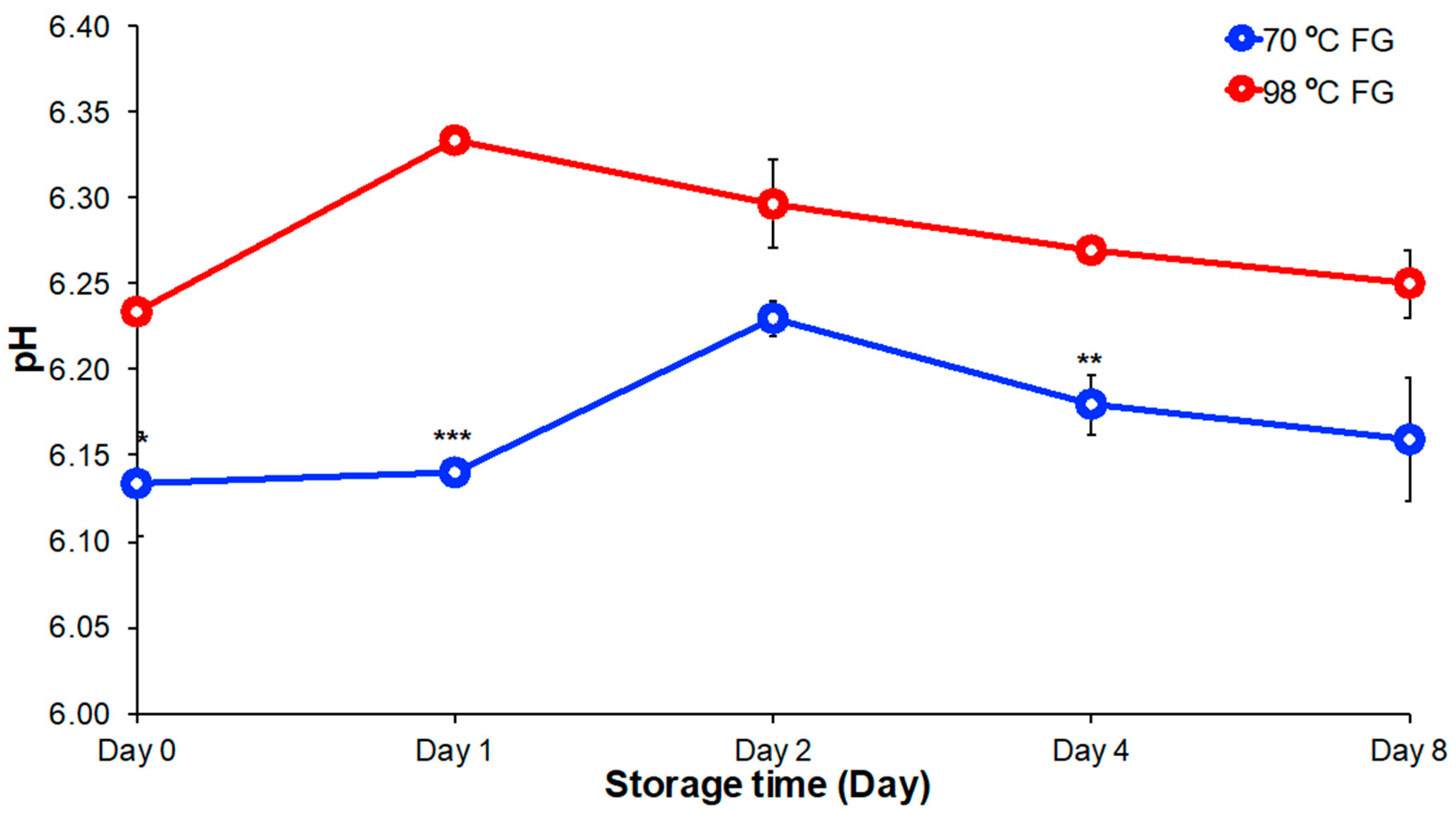
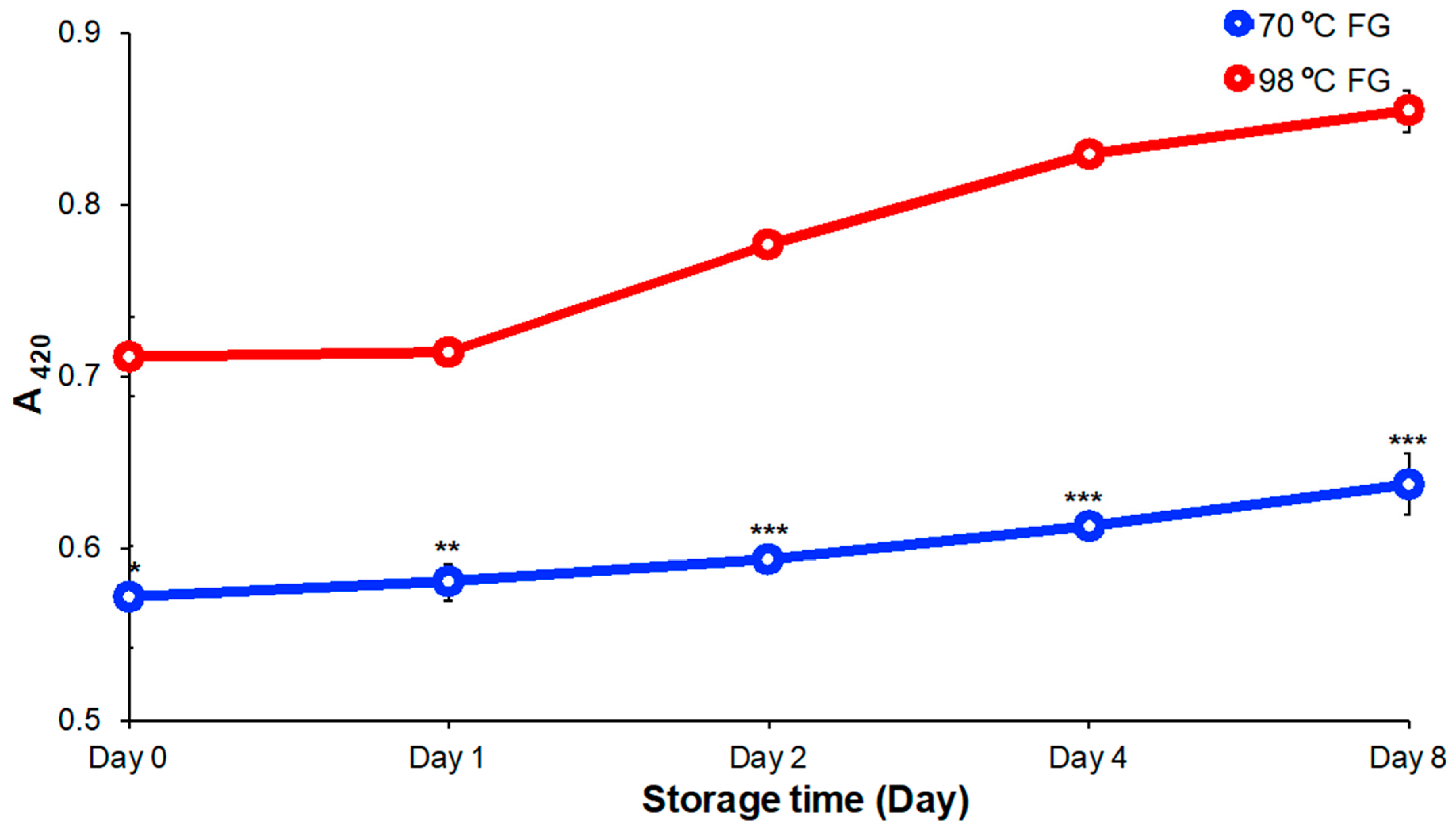
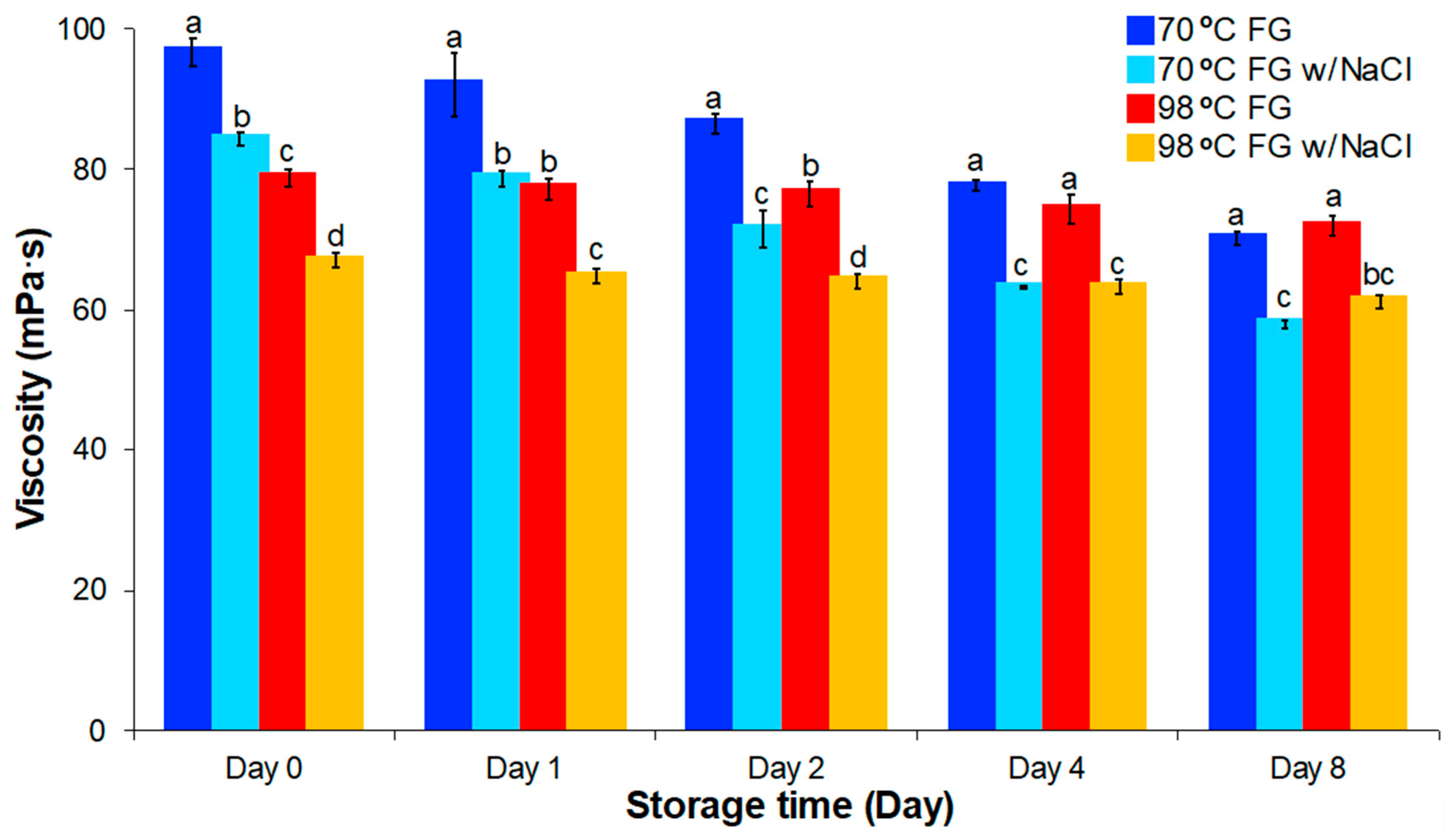
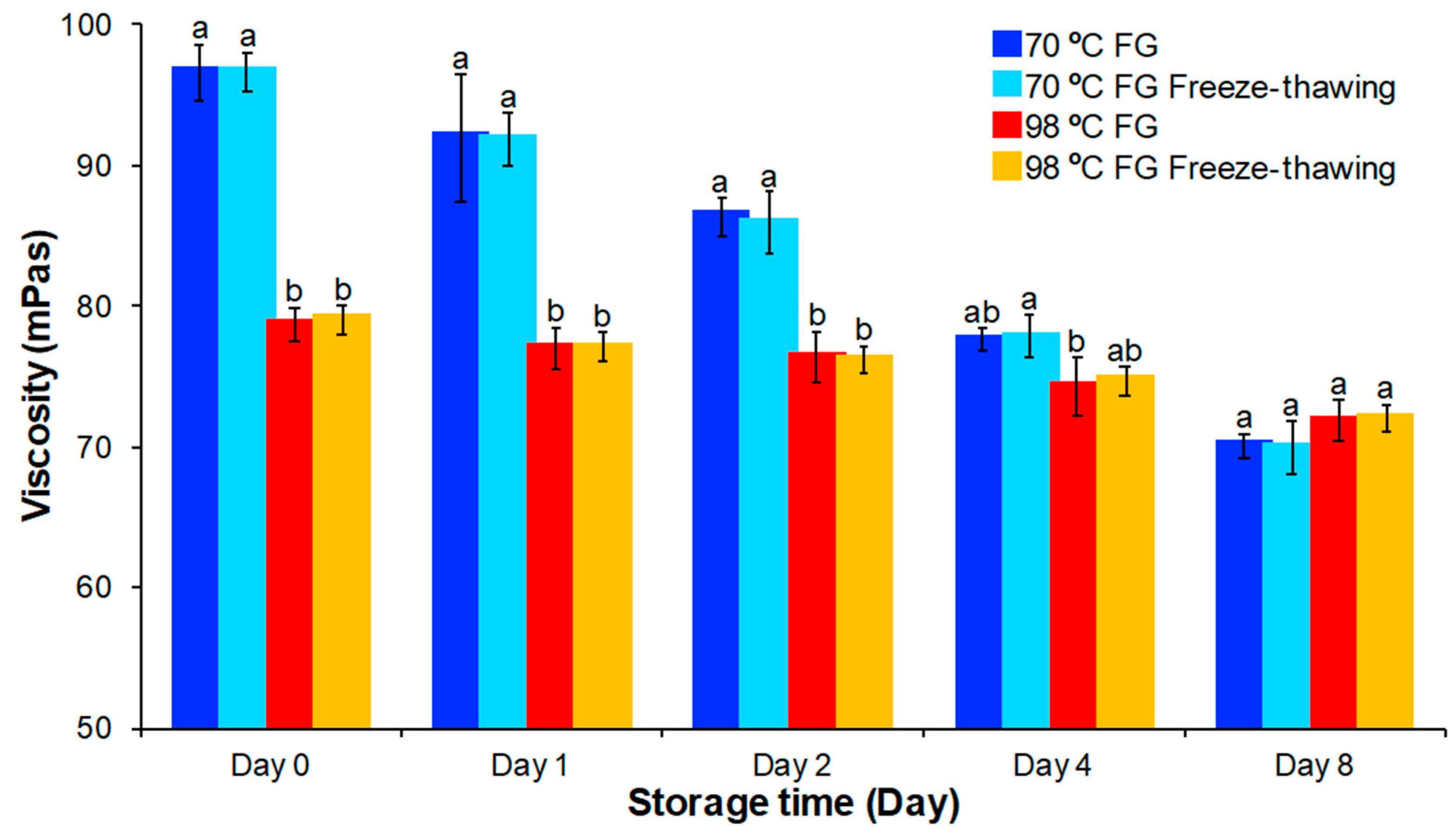

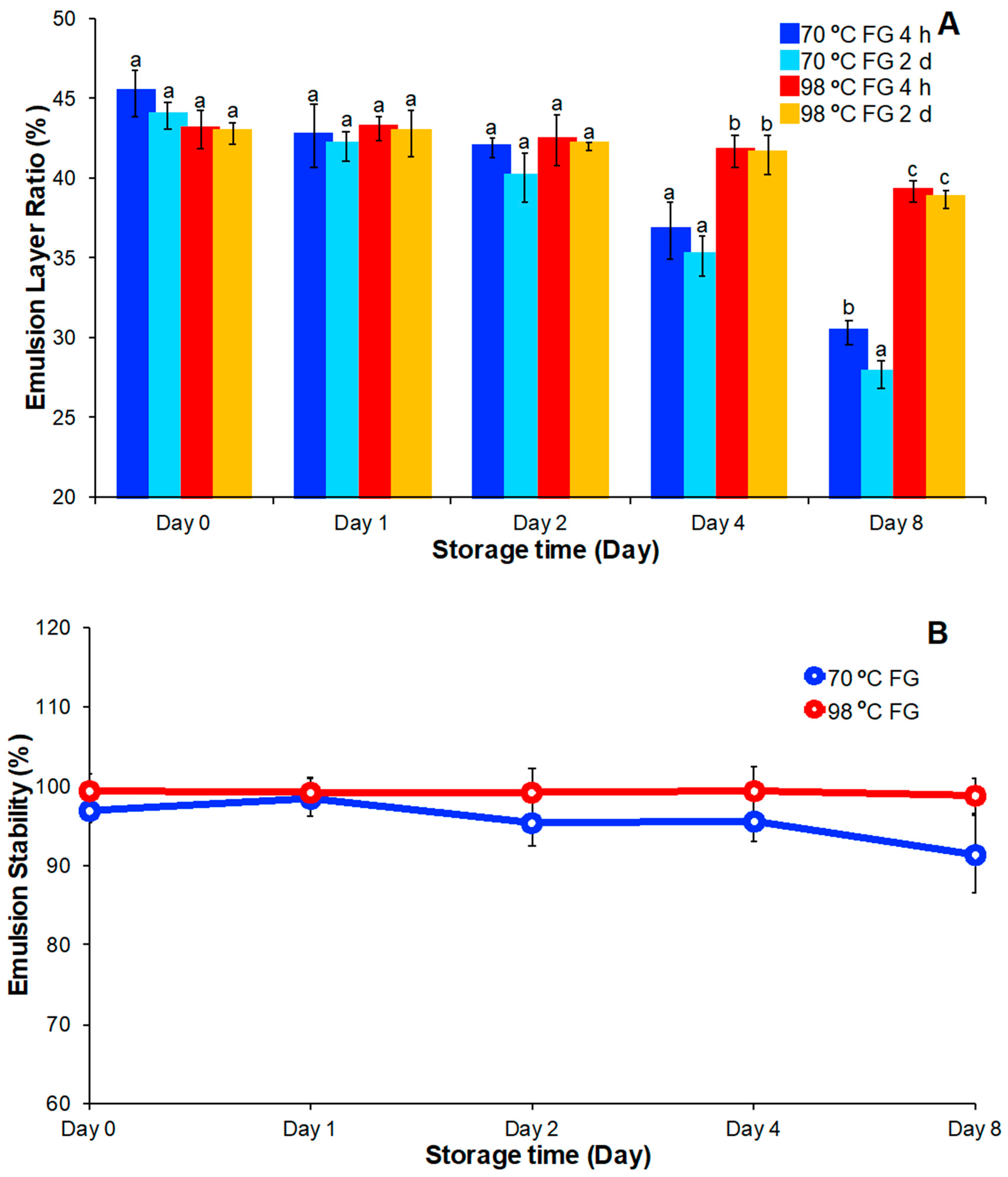
| Storage Time | L* | a* | b* |
|---|---|---|---|
| 70 °C FG | |||
| Day 0 | 11.53 ± 0.15 a | −1.08 ± 0.04 d | −1.77 ± 0.12 b |
| Day 1 | 11.72 ± 0.15 a | −1.21 ± 0.04 c | −1.97 ± 0.06 b |
| Day 2 | 12.47 ± 0.03 b | −1.22 ± 0.23 c | −2.26 ± 0.03 a |
| Day 4 | 12.72 ± 0.03 b | −1.15 ± 0.01 c,d | −2.33 ± 0.06 a |
| Day 8 | 14.92 ± 0.13 c | −1.17 ± 0.02 c | −2.41 ± 0.03 a |
| 98 °C FG | |||
| Day 0 | 16.69 ± 0.11 d | −1.61 ± 0.01 b | 3.58 ± 0.16 g |
| Day 1 | 16.89 ± 0.07 d | −1.73 ± 0.01 a | 3.21 ± 0.09 f |
| Day 2 | 17.25 ± 0.06 e | −1.74 ± 0.00 a | 2.82 ± 0.05 e |
| Day 4 | 17.92 ± 0.04 f | −1.72 ± 0.04 a | 2.54 ± 0.06 d |
| Day 8 | 18.41 ± 0.08 g | −1.67 ± 0.04 a,b | 2.27 ± 0.04 c |
© 2020 by the authors. Licensee MDPI, Basel, Switzerland. This article is an open access article distributed under the terms and conditions of the Creative Commons Attribution (CC BY) license (http://creativecommons.org/licenses/by/4.0/).
Share and Cite
Hu, Y.; Shim, Y.Y.; Reaney, M.J.T. Flaxseed Gum Solution Functional Properties. Foods 2020, 9, 681. https://doi.org/10.3390/foods9050681
Hu Y, Shim YY, Reaney MJT. Flaxseed Gum Solution Functional Properties. Foods. 2020; 9(5):681. https://doi.org/10.3390/foods9050681
Chicago/Turabian StyleHu, Yingxue, Youn Young Shim, and Martin J.T. Reaney. 2020. "Flaxseed Gum Solution Functional Properties" Foods 9, no. 5: 681. https://doi.org/10.3390/foods9050681
APA StyleHu, Y., Shim, Y. Y., & Reaney, M. J. T. (2020). Flaxseed Gum Solution Functional Properties. Foods, 9(5), 681. https://doi.org/10.3390/foods9050681






